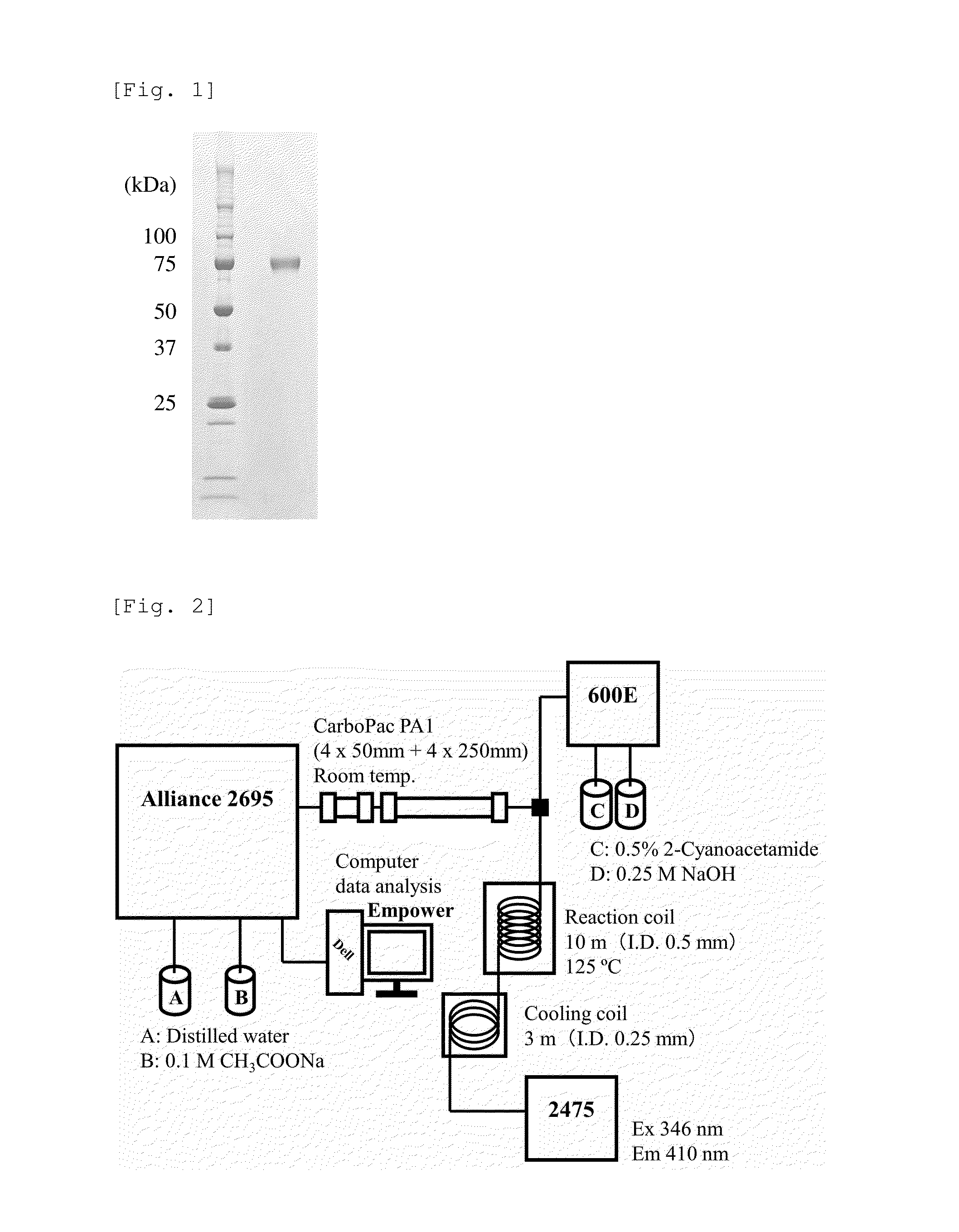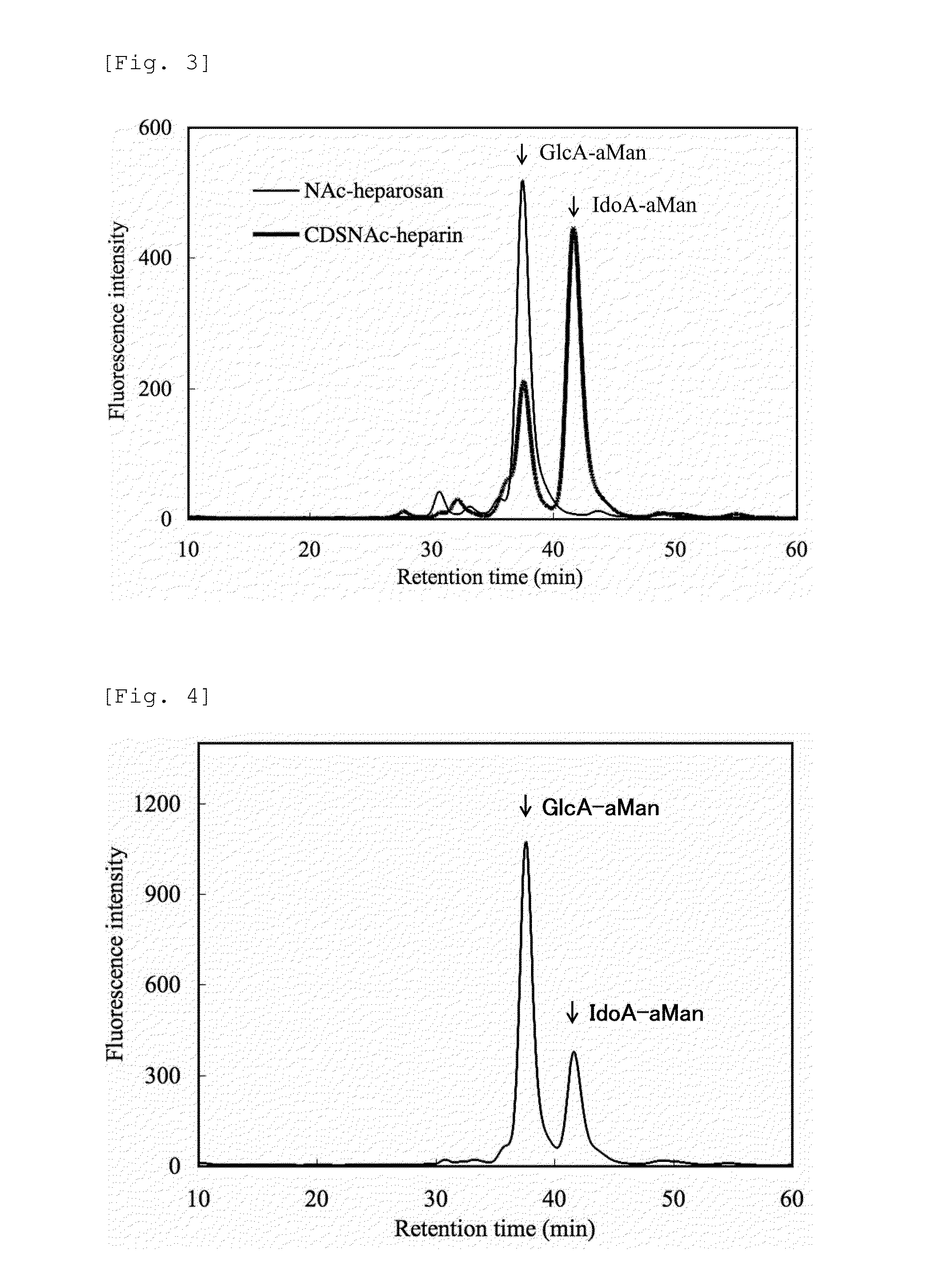Heparosan-glucuronic acid-5-epimerase, and method for producing polysaccharide using same
a technology of heparosanglucuronate and heparosanglucuronate, which is applied in the direction of enzymology, racial mace/epimerase, microorganisms, etc., can solve the problem of enzymatic cascade in biosynthesis that has not been elucidated
- Summary
- Abstract
- Description
- Claims
- Application Information
AI Technical Summary
Benefits of technology
Problems solved by technology
Method used
Image
Examples
example 1
Isolation of mRNA from the Achatina fulica Mucous Gland
[0200]The mRNA of Achatina fulica was obtained through a hot phenol method (e.g., Verwoerd T. C., Dekker B. M., Hoekema A., Nucleic Acids Res. 1989 Mar. 25; 17(6): 2362.) in which the total RNA was extracted from the mucous gland, and the extracted product was purified through a method employing magnetic beads, to thereby isolate mRNA. The specific procedure is described as follows.
[0201]The mucous gland was removed through incision of an Achatina fulica by means of a surgical knife and the removed gland was washed with distilled water. The product was placed in a 1.5-mL tube with a screw sealable cap. The contents were frozen by immersing the tube in liquid nitrogen for one minute, and the gland was crushed by means of a homogenizer. To the crushed product, a hot extraction buffer heated at 80 deg C. in a water bath (i.e., a solution obtained by stirring phenol melted by heating in a water bath at 55° C. with a buffer (0.1M LiC...
example 2
Preparation of Achatina fulica cDNA Phage Library
[0204]cDNA was obtained from mRNA obtained in the aforementioned by means of AccuScript Hi-Fi cDNA Synthesis Kit (product of Agilent Technologies) through a procedure in accordance with an attached protocol. More specifically, reverse transcription was carried out by use of mRNA obtained in the above as a template, an oligo dT primer to which an XhoI site was added (SEQ ID NO: 6), 5-methyl dCTP, and Moloney murine leukemia virus reverse transcriptase (MMLV-RT). Then, in the presence of RNaseH, nick translation by DNA polymerase I was performed, to thereby yield a double-strand cDNA.
[0205]Both ends of the double-strand cDNA were blunted by acting Pfu DNA Polymerase attached to the kit. Then, an EcoRI adaptor (mentioned below) was ligated to the double-strand cDNA by use of DNA Ligation Kit Ver. 2.1 (product of Takara Bio Inc.), through a procedure in accordance with an attached protocol. Subsequently, the cDNA was limitedly digested ...
example 3
Recovery of DNA Fragment Encoding Polypeptide of HG-5Epi
[0208]As host cells (host bacterium) to which the cDNA phage library obtained in is to be infected, E. coli XL-1 Blue MRF′ strain (product of Agilent Technologies) was used. Amplification and recovery of the phage were carried out through a plate lysate method, the details of which are mentioned below.
[0209]The host bacterium was inoculated to a LB medium (containing 0.2% maltose and 10 mM MgSO4) (20 mL) and was subjected to shake culturing overnight at 37° C., to thereby yield a culture broth having an absorbance of about 1.5 at a wavelength of 600 nm. The cDNA phage library solution obtained in was dispensed in an amount of 30 μL into each of the three test tubes (capacity: 50 mL). The host bacterium culture broth (5 mL) was added to each test tube and mixed with the phage. Thereafter, the test tubes were allowed to stand in a water bath at 37° C. for 15 minutes, whereby the host bacterium was infected with the phage partic...
PUM
| Property | Measurement | Unit |
|---|---|---|
| temperature | aaaaa | aaaaa |
| temperature | aaaaa | aaaaa |
| temperature | aaaaa | aaaaa |
Abstract
Description
Claims
Application Information
 Login to View More
Login to View More - R&D
- Intellectual Property
- Life Sciences
- Materials
- Tech Scout
- Unparalleled Data Quality
- Higher Quality Content
- 60% Fewer Hallucinations
Browse by: Latest US Patents, China's latest patents, Technical Efficacy Thesaurus, Application Domain, Technology Topic, Popular Technical Reports.
© 2025 PatSnap. All rights reserved.Legal|Privacy policy|Modern Slavery Act Transparency Statement|Sitemap|About US| Contact US: help@patsnap.com



